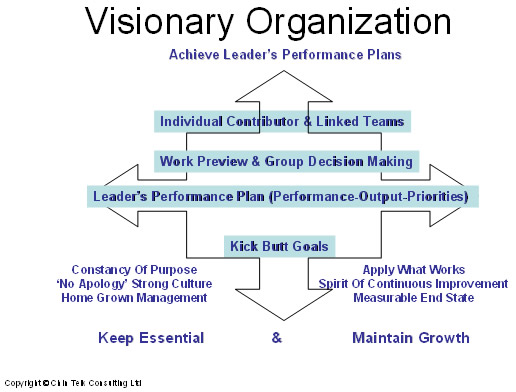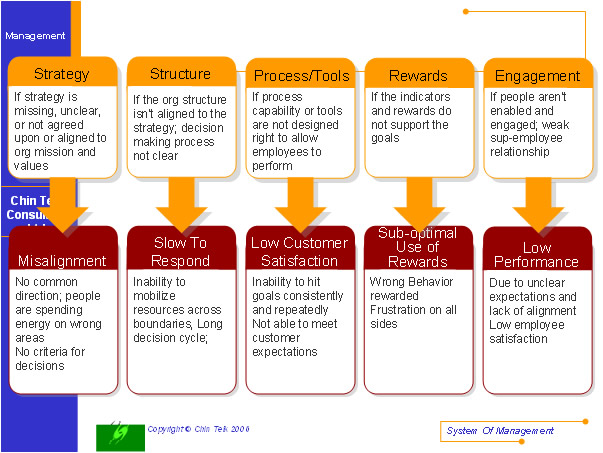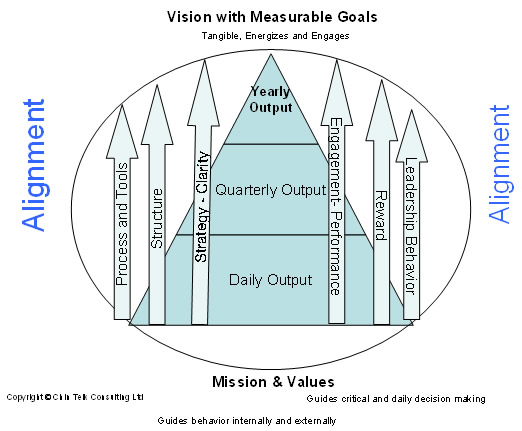 |
|||||||||||||||||||||||||||||||||||||||
| Home | About Chin Teik Consulting Ltd. | Impact of Consulting | Products | Services | Association | Contact Us | |||||||||||||||||||||||||||||||||||||||
| |
|||||||||||||||||||||||||||||||||||||||
| A Visionary Framework for Alignment, Engagement & Results | |||||||||||||||||||||||||||||||||||||||
|
The objective of this article is to share with you what it will take to build and lead an organization that can deliver results, sustainability and scale-ability via employee engagement and organization structure alignment. Visionary (a.k.a. your organization) Organization (figure 1.0) ‘Sustainable’ means the organization’s ‘Vision’ and ‘Measurable Goals’ are so tangible, engaging and focus that they take on a life of its own outlasting any particular leader or leaders over time. The founders of Hewlett Packard created a great company – ‘The HP way’ rather than just focusing on the products. ‘Scaleable’ means that the Organization is able to flex and change according to the environmental forces. That means that there is a level of planning, foresight and organization capability that it can flip on a dime. It is nimble and change-able. It also means that the structure, systems and processes can deal with 5 employees (or customers) and 10,000 employees (or customers). ‘Highly Engaging’ means that the goals, the core ideology, the job scope, the leadership style involves and engages all the employees in the attainment of the organization’s goals and the preservation of the core ideology. ‘Deliver Results’ simply means ‘growth’ as measured by profit, margin, stockholder satisfaction, value-add to the community and market share. It also means to me low wastage as measured by rework caused by errors or cost of quality. To accomplish this, the organization model below consists of some key fundamental blocks:
Figure 1.0: Visionary Organization What is Constancy of Purpose? I came across the term ‘Constancy of Purpose’ from the late Dr. Edwards Deming the father of Total Quality Management. In fact during the re-building of Japan after WWII, Dr. Deming was seconded to Japan to teach the Japanese statistics and process control. Over time as the Japanese adopted Dr. Deming’s teachings, they literally turned the perception around of what ‘Made in Japan’ stood for. Today the world talks about GE’s Six Sigma. Well that came from the late Dr. Deming. Dr. Deming said in his book ‘ Out of the Crisis’, ‘your customers, your suppliers, your employees need your statement of constancy of purpose – your intention to stay in business by providing product and service that will help man to live better and which will have a market’. I have over the years in my role as an internal consultant and an external consultant used the term ‘Constancy of Purpose’ to include an organization’s mission, values and vision. It is the combination of those three that gives the organization focus, motivation and longetivity. It is like the North Star providing navigational direction for ships in the old days. So what is ‘Mission’ or/and ‘Vision’? Over the years, different consultants and management books have used the two terms interchangeably and also in some cases differently. Here are some examples:
Does it matter? Well you can answer that after you have finished reading my article. Misalignment As you can see in figure 2.0 the misalignment of strategy, structure, process/tools, rewards and engagement result in misalignment, slowness to respond, low customer satisfaction, sub-optimal use of rewards and low performance in the organization. So how does one accomplish alignment in an organization? Figure 2.0: Misalignment of Organization Design Visionary Framework To make it simple I have used the following definitions for myself, my own company and also with my clients:
The figure 3.0 shows how important it is to have the alignment of resources, organization and businesses in the corporate strategies to the Vision. Constancy of Purpose provides the guidelines for internal and external behavior and decision. The Vision with Measurable Goals provides the direction and focus. If done right, it also generates energy and longetivity. Then in the middle you can see that the daily output is linked back to the annual target. Reinforcing and supporting individual daily to annual output are the resources (competencies and capabilities), businesses and organization (leadership behavior, structure and tools) strategies. Figure 3.0: Visionary Framework
Collis and Montgomery wrote the following to describe their ‘Triangle of Corporate Strategy’ in their article ‘Creating a Corporate Advantage’. ‘Great corporate strategies come in the first instance from strength in each side of the triangle: high-quality rather than pedestrian resources, strong market positions in attractive industries and efficient administrative organization. But true corporate advantage requires a tight fit of each angle as well. When a company’s resources are critical to the success of its businesses, the result is competitive advantage. When the organization is configured to leverage those resources into the business, synergy can be captured and coordination achieved. Finally a fit between a company’s measurement and reward system and its businesses produce strategic control’. Constancy of Purpose is made up of Mission and Values of the organization Mission is your core purpose in life. It is the organization’s fundamental reason for being. It tells employees, suppliers and customers who you are and what your core is. ‘It captures the soul of the organization’ (Jim Collins ‘Built to Last’). It becomes an organizational constitution, the basis for making major organizational decisions, the basis for making daily decisions in the midst of circumstances and emotions that affect the organization and its employees. Table 1: Examples of Mission
Built to Last by Jim Collins and Jerry I. Porras These examples are not meant for you to copy. Mission is something you discover. It has to be authentic and from within. Lip service and putting mission statements on the wall is not good enough. Everyone from the top leadership down to the individual contributor has to live it. Vision with Measurable Goals Vision is where you see your organization in the future. The trick with Vision is how much do you daydream or hallucinate versus how much you box yourself in with your present capability. So the balance comes from using measurable success measures so that it does not remain a daydream. I believe in this saying - ‘What you cannot measure you cannot change’. That is why I chose to use ‘Vision with Measurable Goals’. Vision with Measurable Goals
GE’s core is so strong that while they have different businesses and they keep reinventing themselves, their core does not change. Their core keeps them steady. What are strategies? Strategies are a means to an end. It is the ‘how’ of hitting the goals or the measurable end state! Kenneth R. Andrews said that ‘strategy is a match between what a company can do (strengths and weaknesses) within the universe of what it might do (environment opportunities and threats). This has become the standard SWOT (Strength, Weakness, Opportunity and Threat) that most companies use to define their strategies. Stalk, Evans and Shulman in a Harvard Business Review article on ‘Competing on Capabilities’ say the following: ‘To succeed a company must weave its key business processes into hard-to-imitate strategic capabilities that distinguish it from its competitors in the eyes of customers.’ Blue Ocean Strategy book authors described three strategies – focus, divergence and tagline. In the book, the authors also talk about the need to be able to do both strategies – differentiation and cost. Collins and Porras of ‘Built to Last’ talks about the ‘Tyranny of the Or’ and embrace the ‘Genius of the And’. So it is not about being able to differentiate without a total cost solution or vice versa. It is being able to do both. Table 2: Jim Collins ‘Tyranny of the OR’ versus ‘Genius of the And’ (From “Built To Last’)
Built to Last by Jim Collins and Jerry I. Porras There is not such thing as one size fits all in terms of strategy that works. Every company is different and is at different stages of organization life cycle with different operating context and fundamentally different kind of resources. The key is the logic of internally consistent and aligned strategies tailored to a firm’s constancy of purpose, capabilities and opportunities. Then at the same time, the organization’s tools, organization structure, capabilities and competencies and reward must be aligned to support the strategies which support the Constancy of Purpose. This is how you achieve alignment. Below four points on corporate strategy:
It is not enough to just develop a mission statement, vision statement, values and strategies. The organization must then put equal or more effort and energy to take the constancy of purpose and vision throughout the organization. Remember it is not about putting posters on the wall about the mission, values, vision and strategies. It has to be part of the DNA of the organization as lived out by consistent and constant actions. Anytime, you are solving a problem or seizing an external opportunity, change is created and rippled through the organization. Managing Change and Transition is a very key organization capability which can be a competitive differentiator. I have attached a ‘Leading Change’ by John Kotter which I have used in slightly different forms with different organizations. They are good guidelines in terms of how to apply the steps to manage change in an organization. Table 3: Eight-Stage Process for Creating Major Change by John Kotter
One of the approaches I have taken was to transform a regular senior management staff into a guiding coalition. What I did was to rearrange the staff meeting agenda into one part ‘day-to-day reviews and directions’ and one part ‘long term strategic steering and guiding’. Another approach I have taken was to take a section of the senior staff management team and make them the guiding coalition for the organization. They were called ‘Steering Council’. ‘Pace’ is a very important tool that keeps the organization on its toes. However it needs to be real in terms of ‘urgency’ if not it will become a ‘cry wolf’ phenomena which is a negative effect. Summary I am not so much into labels but more on the consistent application and living out the principles behind the labels. You can decide to use mission and vision interchangeably or have Vision drive Mission etc. The key points are:
Enjoy the Journey! Resources:
Copyright © 2007 Chin Teik Consulting Ltd
|
|||||||||||||||||||||||||||||||||||||||
| Home | About Chin Teik Consulting Ltd. | Impact of Consulting | Products | Services | Association | Contact Us |


